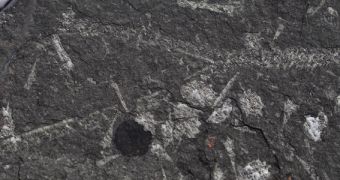Scientists investigating a very old rock discovered signs of an ancient type of plankton that was capable of building complex colonies at a point of time when other organisms were incapable of such complex organization and cohabitation.
Signs of the colonies were discovered inside a rock specimen that had been analyzed many times before. However, the indications that led University of Leicester geologist and study researcher Jan Zalasiewicz to the new findings were overlooked by other teams.
He found a very old graptolite colony, which was most likely constructed around 443 million years ago, at the end of the Ordovician period. No such organisms can be found alive today, and the closest living relatives for these animals are worm-like creatures called pterobranches, which live in tubes on the ocean floor.
“They are also animal architects (they build their own living tubes) but these are rather untidy, simple structures in comparison to the finely engineered, tightly organized living quarters of the graptolites,” Zalasiewicz tells LiveScience.

 14 DAY TRIAL //
14 DAY TRIAL //